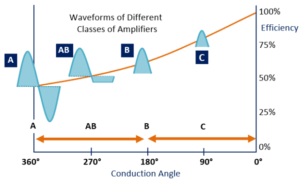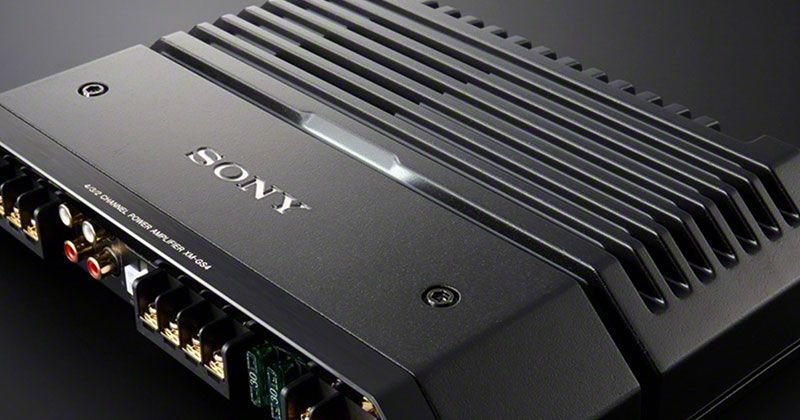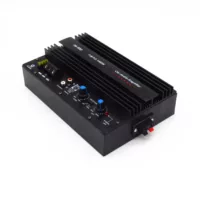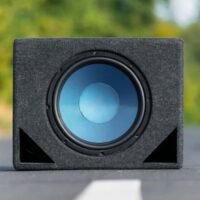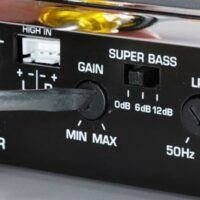While most car amplifiers serve the same functions and work the same way, they combine power and signal differently. The class of an Amp determines its efficiency, which in turn indicates its class. While it is highly recommended to purchase amps with the best class, it is important to always consider other factors to get the best amp for yourself. What are car amplifier classes and which is best for you?
Amp classes are divided into numerous classes, but the ones found in cars are Class A, B, AB, and Class D. These classes differ in performance and have different elements. With a better amp class comes better sound output through your speakers. Amplifier class differs in efficiency and sound fidelity. Sound efficiency shows the percentage of output current compared to consumed current, and the percentage of time it conducts. The residual in current is what causes heat and is responsible for distorted sound and component damage.
The different classes of Amplifiers generate various proportions of heat. No amp uses all the power it receives but some classes have found ways to work more efficiently. Cars owners choose amplifier classes based on their needs. What are your needs and which amp class best suits those needs?
Table of Contents
Class Amp Comparison
| Class A | Class B | Class AB | Class D |
| High Sound Fidelity | Low Sound Fidelity | High Sound Fidelity | Medium Fidelity |
| Poor Efficiency | Efficient | Efficient | High Efficiency |
| Large | Smaller | Smaller | Compact |
| Low Distortions | Cross Over Distortions | Lesser Distortions | High-Frequency Distortions |
| Expensive | Reasonably-Priced | Reasonably-Priced | Reasonably-Priced |
What are Class A Amplifiers
Class A amplifiers are biased in the sense that they waste over 50% of energy as they are always in a consumption state, regardless of the input signal. A class A amplifier uses only 25% of input power with the remaining 75% turning into heat and causing problems for your amps. Inefficient and big, class-A amplifiers put a heavy strain on car batteries and alternator, therefore are not common with cars. They are expensive, incur higher costs, and are bigger than the rest classes in design.
Notwithstanding a couple of setbacks, the Class A Amplifier has its benefits. While it is big, class-A amps are simpler to use, produce better frequency, and creates low distortions. Class A amps have high fidelity, reproducing sound with accuracy. These are some of the best characteristics of any amplifier.
Buying a Class A amplifier? Then be sure that the amp is designed to work for extended periods and carry heavy loads like your subwoofers. Without putting this into consideration, your class A amp might suffer shortened lifespan. The Class A Amplifier is great for stereo constantly receiving signals.
What are Class B Amplifiers
The class B Amplifiers are in direct contrast with the Class A amps, as they are equipped with internal circuit switches that stop their output transistors in the absence of signals. This creates less heat, thereby extending the amplifier’s lifespan and protecting internal components from damage.
However, by equipping it with 2 transistors to switch on and power off the amp, it leads to what is known as crossover distortion. While efficient, class B amplifiers have a reputation for having low fidelity. While efficiency extends the amp’s lifespan, its accompanying low fidelity reduces the quality of sound.
Car brands avoid installing Class B Factory amps because of these defects. Nonetheless, class B amps are still great and to combat these defects, car manufacturers are now combining the features of different amp classes.
What are Class AB Amplifiers
The AB amplifiers are a hybrid of Class A and B, picking up the benefits of the other while eliminating their combined weaknesses. Unlike the class A amp, AB is more efficient just like class B but creates better sound fidelity. I.e no sound distortions. This is possible by using the class A bass but with a modification that allows the amp to stay on and efficiently pick low signals without crossover distortions.
Class AB amplifiers also have great sizes and are the preferable option for most car manufacturers and aftermath brands.
What are Class D Amplifiers
Class D amps are the most common class in cars. They have up to 90% efficiency and produce good sound fidelity. Class D uses pulse width modulation for control. Unlike the other amp classes, the class D amplifier is either off or on, and switches between both points with amazing speed. While this might have caused low sound fidelity, thereby causing sound distortions, class D is equipped with a low pass filter that removes distortions, thereby enabling a continuous analog output.
Class D amplifiers are the go-to option for car manufacturers and aftermath brands.
There are numerous other classes, including Class C, E, F, G, and H. However, these classes are simply a modification of the above-mentioned classes. For example, the class G and H classes have more efficient techniques than class AB. However, be sure to confirm with your dealer before installing any amp into your car.
Which Amplifier is Best For Your Needs
Choosing an amp class largely depends on your needs and the size of your car. Also, do you would want to consider the load on your battery and alternator. Your answers to these questions will determine the right choice for you. While Class A amps are popular, in-car usage is low because of their large size and inefficiency. The heat generated by wasted energy in a class A amplifier will reduce the lifespan of the internal component. However, if you’re looking to power strong subwoofers and want low distortions, the class A amps are a great choice.
Class A amplifiers are more suitable for outdoor use. This class will provide the best sound experience when used for large outdoor events. Clear sound, free of crossover distortion. For an extended lifespan, it is recommended that you use your Class-A with sufficient ventilation.
But if you’re unable to invest in additional ventilation, then install one out of Class B, AB, or D class. These classes are more efficient and generate lesser heat. However, sound fidelity can become a problem real quick. The switch in class B creates crossover distortions but upgrading to class D promises better sound fidelity as it uses a low pass filter to quickly switch on and off.
Prioritize cost, durability, efficiency, and sound fidelity when buying your next car amp. You should also think about comfort and convenience, so avoid big amps for small cars.
The Best Amplifier Class For Cars
The different classes of amplifiers suit different settings. But for a car, your best choices are in between class A/B and D. These classes provide the best efficiency and have good sound fidelity. They are also portable and can fit into most cars. However, if you’re going to power large speakers ans subwoofers in larger vehicles with enough space and ventilation, you might want to consider an A-class amplifier.
Why You Should Use The Best Amp System
Here are the benefits of replacing your old amp with a new one.
● Improved sound quality
Improved sound quality, even with distortions is the number one sign of a new amplifier. Your sound becomes clearer and you’re able to enjoy your stereo for longer periods.
● Increases speaker volumes
Newer amps deliver better power to your speakers and subwoofers, thereby enabling louder volumes. A new amp reduces the pressure on your gain control and allows you to cruise on a fixed gain placement.
● Cheaper recurring costs
Older amps may frequently require repairs and expensive maintenance. Consequent repairs may incur large costs. Buying a new amp might seem costly at first, but it eliminates any recurring costs, thereby protecting your finances.
Conclusively, an amplifier class is a system that prioritizes different characteristics to enunciated certain advantages. Always lookout for the best amp class that is best suited for your car.
